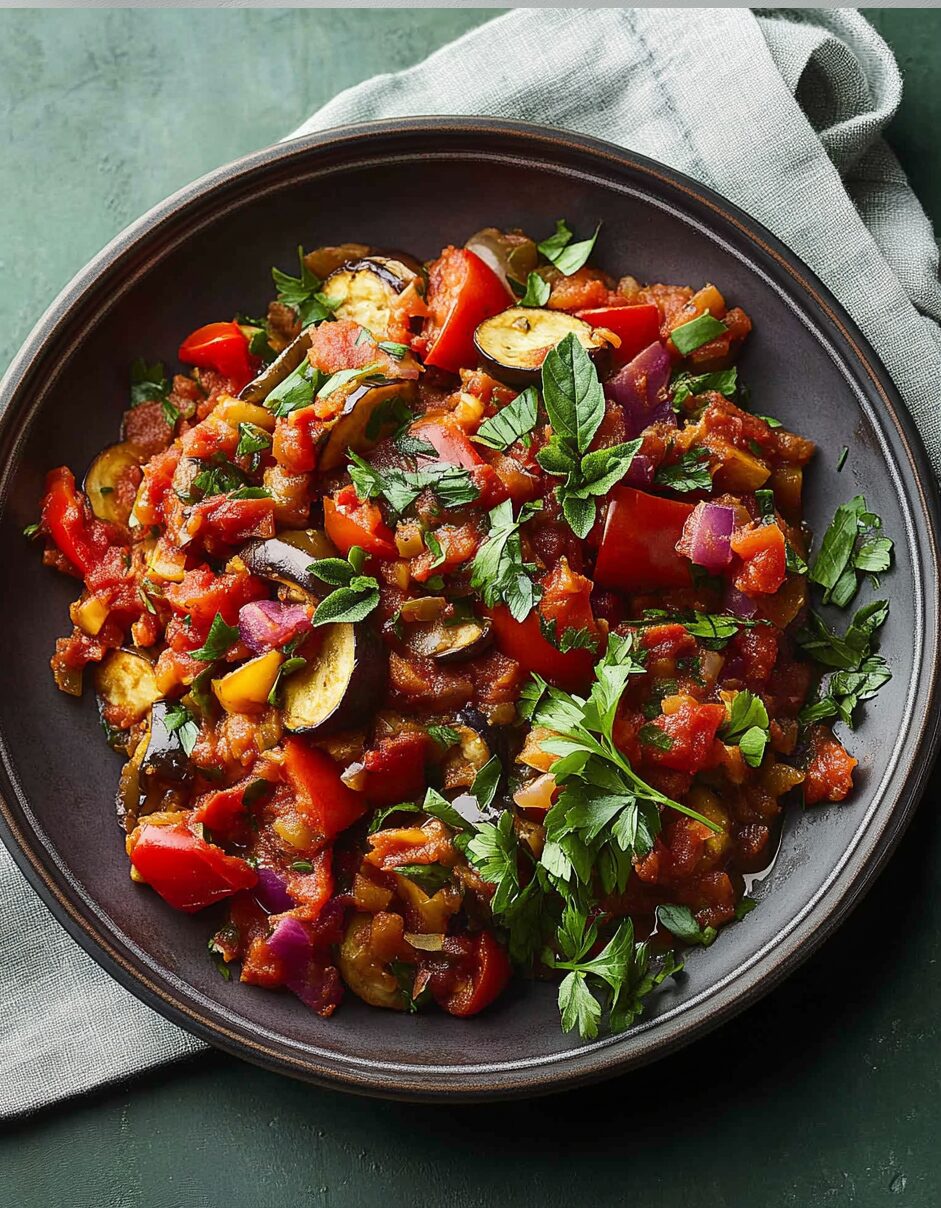The Sicilian Eggplant Caponata is a timeless classic that brings the vibrant flavors of Italy straight to your table. This dish combines tender eggplants, tangy tomatoes, and briny olives for a harmonious balance of sweet and savory.
Traditionally served as an antipasto, this versatile dish also makes a perfect side or even a main course when paired with crusty bread. Its bold flavors and beautiful presentation make it an irresistible addition to any meal, celebrating the simplicity and richness of Mediterranean cuisine.
Full Recipe:
Ingredients:
- 2 medium eggplants, diced
- 1 medium onion, chopped
- 3 celery stalks, sliced
- 1/4 cup olive oil
- 2 garlic cloves, minced
- 1 can (14.5 oz) diced tomatoes, drained
- 1/4 cup green olives, chopped
- 2 tablespoons capers, rinsed
- 1/4 cup red wine vinegar
- 2 tablespoons sugar
- Salt and black pepper to taste
- Fresh parsley, chopped, for garnish
Directions:
- Heat olive oil in a large skillet over medium heat. Add the eggplant and cook until softened and lightly browned, about 10 minutes. Remove and set aside.
- In the same skillet, add more olive oil if needed. Sauté the onion, celery, and garlic until softened, about 5 minutes.
- Add the diced tomatoes, green olives, and capers to the skillet, stirring to combine.
- Return the cooked eggplant to the skillet. Stir in the red wine vinegar, sugar, salt, and pepper. Simmer for 15–20 minutes, allowing the flavors to meld.
- Remove from heat, garnish with fresh parsley, and serve warm or at room temperature.
Prep Time: 10 minutes | Cooking Time: 30 minutes | Total Time: 40 minutes
Kcal: 150 kcal | Servings: 4 servings
Historical Background
Eggplant Caponata, or simply “Caponata,” hails from Sicily, a southern Italian region known for its vibrant and diverse culinary heritage. The dish is a testament to Sicily’s history as a cultural crossroads. With influences from Arab, Greek, and Spanish cuisines, Caponata embodies the Mediterranean tradition of combining fresh vegetables with bold, tangy flavors.
Originally, Caponata was served as a main dish with bread, but over time, it evolved into a versatile accompaniment to fish, meat, or pasta. Today, it is enjoyed worldwide as a relish, appetizer, or even a topping for crostini.
Nutritional Benefits
Caponata is as nutritious as it is delicious. It features eggplant as the star ingredient, a vegetable rich in antioxidants, fiber, and essential nutrients. Combined with tomatoes, olives, and capers, this dish delivers a powerful dose of vitamins, minerals, and heart-healthy fats.
- Eggplant: High in fiber, low in calories, and a great source of vitamins C, K, and B6. It also contains nasunin, an antioxidant known to support brain health.
- Tomatoes: Packed with lycopene, a powerful antioxidant with cancer-fighting properties.
- Olive Oil: Provides monounsaturated fats that help reduce inflammation and improve heart health.
- Capers and Olives: Add a salty, umami-rich punch while contributing small amounts of vitamin E and healthy fats.
This dish is naturally vegan and gluten-free, making it an excellent option for a variety of dietary needs.
Serving Suggestions
Caponata is incredibly versatile. Here are some creative ways to serve it:
- As a Topping: Spread over toasted crostini or flatbreads for a flavorful appetizer.
- With Protein: Pair with grilled fish, roasted chicken, or even tofu for a complete meal.
- On Pasta: Toss with spaghetti or penne for a quick and hearty Italian-inspired meal.
- As a Side: Serve alongside a charcuterie board or as a complement to a rich entrée.
- Chilled: Let the flavors meld overnight and serve cold as part of an antipasto platter.
Cooking Tips
- Degorging Eggplant: Salting the eggplant beforehand is crucial to remove bitterness and achieve a tender texture. Don’t skip this step for the best results.
- Balance the Flavors: The beauty of Caponata lies in its balance of sweet, tangy, and savory. Adjust the sugar, vinegar, and salt to suit your taste preferences.
- Use Fresh Ingredients: Whenever possible, opt for fresh tomatoes, herbs, and high-quality olive oil to capture the authentic Sicilian flavor.
- Make Ahead: Caponata tastes even better the next day after the flavors have had time to meld.
Regional Variations
Sicily’s diverse provinces have given rise to many variations of Caponata. While this recipe is a classic version, here are a few regional twists:
- Palermo Style: Often includes raisins and pine nuts for added sweetness and crunch.
- Catania Style: Features bell peppers and anchovies for an extra savory punch.
- Trapani Style: Sometimes includes almonds or hard-boiled eggs as garnishes.
Storage
Caponata stores beautifully, making it ideal for meal prep or hosting:
- Refrigerator: Store in an airtight container for up to 5 days. The flavors improve over time.
- Freezer: Freeze in portions for up to 3 months. Thaw in the fridge and enjoy cold or reheated.
Cultural Notes
Caponata’s name is thought to derive from “capón,” a type of bread that was traditionally served with this dish to soak up its delicious juices. In Sicilian households, it is considered a comfort food and a staple at festive gatherings, showcasing the region’s love for simple yet flavorful cooking.
With these rich details, your website article will offer readers not only a great recipe but also a deep dive into the cultural and culinary significance of Eggplant Caponata!
A Closer Look at Key Ingredients
Every ingredient in Eggplant Caponata plays a crucial role in its signature flavor profile. Here’s a breakdown of the key components:
- Eggplant:
- Eggplant is the heart of Caponata, providing a meaty texture and the ability to absorb flavors beautifully. In Sicilian cuisine, eggplants are often fried to bring out their rich, earthy taste. The salting process not only removes bitterness but also ensures the eggplant doesn’t become soggy during cooking.
- Celery:
- Celery adds a subtle crunch, balancing the softness of the eggplant and other ingredients. It also contributes a slightly herbal note that complements the sweet and tangy flavors.
- Tomatoes:
- Fresh, ripe tomatoes or high-quality canned varieties bring acidity and a natural sweetness to the dish. Tomatoes serve as the base, tying together the other ingredients.
- Olives and Capers:
- These briny additions are the soul of Caponata. They lend a salty depth and umami richness that elevates the overall flavor.
- Vinegar and Sugar:
- The interplay of vinegar and sugar creates the dish’s signature agrodolce (sweet and sour) flavor, a hallmark of Sicilian cuisine. This balance is key to achieving an authentic taste.
- Olive Oil:
- A generous amount of extra virgin olive oil not only helps cook the ingredients but also enhances the dish’s luxurious mouthfeel.
- Fresh Herbs:
- Oregano and parsley bring brightness and a touch of Mediterranean aroma, providing the perfect finishing note.
Historical and Culinary Importance
Eggplant Caponata is a culinary reflection of Sicily’s vibrant history. Over the centuries, the island was influenced by Greeks, Romans, Arabs, Normans, and Spaniards. Each of these cultures left its mark on Sicilian cuisine, and Caponata is a prime example:
- The Arabs introduced eggplant, vinegar, and the agrodolce flavor profile.
- The Spanish brought tomatoes and peppers to Europe, which eventually became staples in Caponata.
- The combination of diverse ingredients and techniques illustrates how Sicilians adopted and adapted external influences into their own culinary traditions.
In many ways, Caponata represents the essence of Sicilian cooking: resourceful, flavorful, and deeply rooted in cultural pride.
Why Eggplant Caponata Stands Out
- Versatility:
Whether served as a side dish, a topping, or a main course, Caponata can transform any meal into a Mediterranean feast. - Healthy and Wholesome:
With no animal products and a focus on vegetables, Caponata aligns with modern dietary trends like veganism and the Mediterranean diet. - A Dish for Every Season:
Caponata can be enjoyed warm, at room temperature, or chilled, making it suitable for any time of year.
Fun Facts About Caponata
- Caponata is often referred to as a “vegetable symphony” because of the harmony between its components.
- In ancient times, it was a common practice to make large batches of Caponata to preserve the summer harvest for the colder months.
- The agrodolce flavor profile of Caponata is also found in other Sicilian dishes, such as sweet and sour sardines (sarde in saor).
How to Make It Your Own
One of the best things about Caponata is its adaptability. Here are a few ideas to personalize the dish:
- Add Protein: Mix in chickpeas, lentils, or cubes of firm tofu for a heartier version.
- Use Seasonal Vegetables: Bell peppers, zucchini, or fennel can be great additions depending on what’s in season.
- Spice It Up: Add a pinch of red pepper flakes or chili powder for a touch of heat.
- Experiment with Garnishes: Try topping the dish with toasted pine nuts, slivered almonds, or even a drizzle of pomegranate molasses.
Pairing Suggestions
Caponata pairs beautifully with a variety of dishes and drinks:
- Bread or Crackers: Serve with crusty bread, flatbreads, or whole-grain crackers for dipping.
- Seafood: Pair with grilled swordfish, shrimp, or baked cod to echo the Mediterranean vibe.
- Wine: A chilled glass of Sicilian white wine, like Grillo or Catarratto, enhances the dish’s tangy notes.
- Cheese: Serve alongside creamy ricotta or a sharp pecorino to add a contrasting texture.
Conclusion
Eggplant Caponata is a timeless Sicilian classic that balances sweet, tangy, and savory flavors in every bite. Its versatility makes it perfect as a side, appetizer, or main dish, while its wholesome ingredients cater to modern dietary trends.
By preparing this dish, you’re embracing the rich culinary heritage of Sicily and bringing Mediterranean warmth to your table. Whether served warm or chilled, Caponata is a flavorful way to experience the heart of Italian cuisine.






